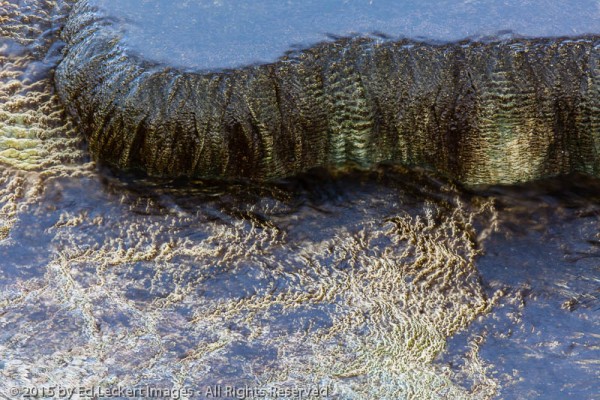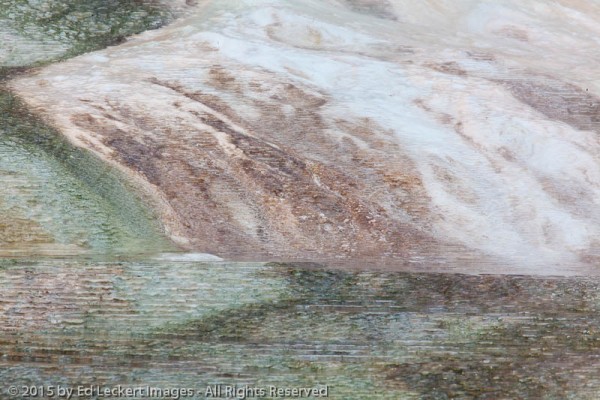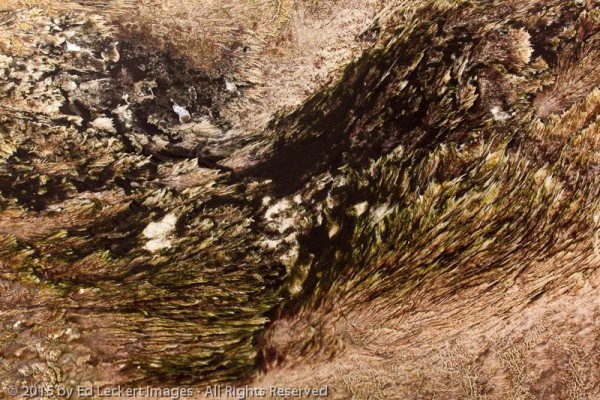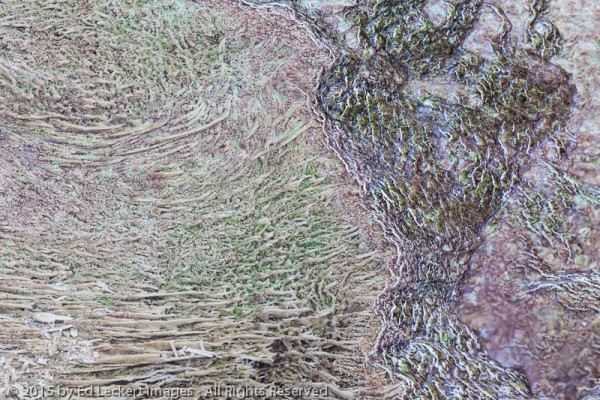


When people think of steaming vents and boiling water at Yellowstone, they usually think of the famous geyser, Old Faithful. But Yellowstone is not a one-trick pony, and the super-heated underground water at the park’s original entrance has a completely different way of inspiring awe in park visitors.
Yellowstone National Park consists of several geyser basins as well as other geothermal features such as hot springs, mud pots, and fumaroles. In fact, the geothermal activity of the Yellowstone supervolcano has created an estimated 10,000 thermal features in Yellowstone. And at Mammoth Hot Springs near the northwest entrance to the park, the featured feature, if you will, is the hot springs and the travertine terraces they create.

Hot mineral water flows over a small travertine terrace, at Mammoth Hot Springs, Yellowstone National Park, Wyoming.
Travertine is a form of limestone that forms around mineral hot springs. The rapid precipitation of calcium carbonate from the water forms terraces, cones, and other structures near the mouth of the hot springs. At first the travertine is white, tan, or cream-colored, though it does form interesting fibrous or concentric shapes. But after a while, the travertine starts to take on beautiful colors because of thermophiles, trillions of tiny microorganisms that thrive in hot temperatures and, grouped together, appear as masses of color.

Patterns in the travertine near Canary Spring look more like a painting than reality, at Mammoth Hot Springs, Yellowstone National Park, Wyoming.
Now, these thermophiles are like your girlfriend, and have a pretty narrow range of temperature that they can tolerate, so as the travertine builds up (which it does rapidly) and the flow of water changes, the temperature at a given spot changes. When this happens, the thermophiles living there die off and are replaced by new thermophiles that prefer the new temperature. And, since the different types of thermophiles are different colors, the area takes on the color of the new inhabitants.

Travertine takes on a variety of shapes and patterns, at Mammoth Hot Springs, Yellowstone National Park, Wyoming.
If the water dries up altogether in a location, everybody dies, and the travertine turns white again. This is the reason that the colors and shapes of the travertine will change over time, and may look completely different from one park visit to your next.
Mammoth Hot Springs is located near the northwest entrance to the park near the gateway town of Gardiner, Montana, and is open year-round. Gardiner, just five miles from Mammoth Hot Springs, is a great place to stay during your visit, or you can stay in the Mammoth Hot Springs Hotel.

Travertine takes on a variety of shapes and patterns, at Mammoth Hot Springs, Yellowstone National Park, Wyoming.
Yellowstone National Park occupies the northwest corner of Wyoming, slightly overlapping Montana to the north and Idaho to the west. Gardiner is about 60 miles south of I-90 in the Bozeman area.

A series of travertine terraces have the appearance of large cliffs, at Mammoth Hot Springs, Yellowstone National Park, Wyoming.
So while we wait for the Yellowstone Supervolcano to wipe out civilization, come out and enjoy the beauty of the terraces!
